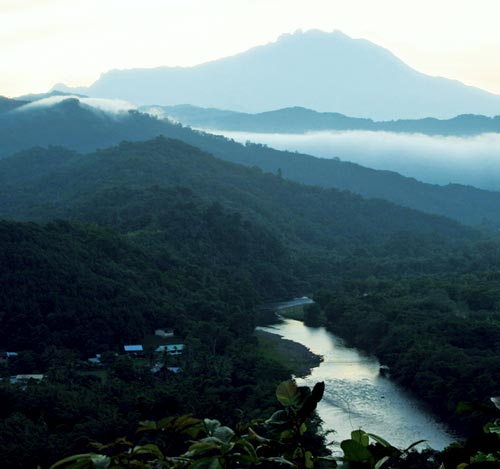



Maiden voyage
I had been racing to put the finishing touches to our new launch, the Puyoh, before the family arrived. From now on, speed-boats, even the catamaran, were strictly for river travel, or for a fast passage to the Gum in the flattest of flat calms. I was not going to take any risks with the family, after my experience in the Pekaka.
The Puyoh was a sea-going kumpit. It had been built for us at the boatyard on the island of Libaran. The hull was a traditional local design which was absolutely seaworthy, and we had it fitted with a big, reliable diesel inboard engine.
Lai had now left his position on the Mantanani, and we appointed him as our sarang. During the building of the Puyoh, he stayed at Libaran checking every detail of the construction; ensuring that only the very best quality well-seasoned hardwood was being used; and making suggestions about strengthening a bit here and there.
When the hull was completed to Lai’s satisfaction, he had brought it round to Sandakan, where it was fitted out with a cabin, a small galley and a toilet. It was painted a smart blue and white, and it looked to my inexperienced eye like the sort of thing you might expect to see on the Riviera.
The girls could hardly wait to see their new home in the jungle. However, the windows in the superstructure of the Puyoh’s cabin were not yet fitted. The Sandakan carpenters were being inordinately slow. I decided after a day or two in town, that we could go up to the estate without the windows and let Kong Miew finish them off when we got there.
We set off from the Sandakan yacht club on a beautiful bright morning, with the sun sparkling on the waves. Ibrahim had announced that, in view of our precious cargo, he would accompany us for this first trip. No one knew the coast, from Sandakan to the Labuk River, as well as Ibrahim. Also, having seen the awe in which he was held by the Sulok community, I felt that his presence was the best possible insurance in the event that we encountered any pirates.
For the first few hours of the Puyoh’s maiden trip, everything went well. The family could not have had a better introduction to the country. We anchored off one of the Turtle Islands for a picnic and a swim, before turning west into Labuk Bay.
As we were passing the Gum estuary, we hit a sharp squall. The ship started to rock around uncomfortably. It was nothing the Puyoh could not handle quite easily. However Lai and Ibrahim suggested that, since we had Olive and the children on board, we should anchor until it passed over. Coincidentally, we anchored in almost the exact spot where Tundah and I had found the huge kumpit anchored on the night of the storm.
The squall brought a rainstorm with it, and since we had no windows in the cabin, the rain poured straight in. Within half an hour we had a few inches of water sloshing around the floor of the cabin. Being at anchor, the Puyoh was rolling around a bit. Olive was fortunately an excellent sailor and so it seemed were the two girls. None of them were sick. It was not particularly comfortable, however.
It was lucky that Olive took it all in her stride. In fact she coped well with all the privations we were to encounter in the first few years, and I took this very much for granted. It was not until much later that I learned from friends living in more civilised areas, that some wives might have had considerable problems in coping with life in the jungle – with storms and floods, and pirates, and falling trees, and insects, and snakes in the wardrobes and rats in the toilets.
After an uncomfortable hour or so, the sun came out again to dry everything off, and we were on our way up the bay. As we proceeded up the river, the girls were excited when the proboscis monkeys came out to greet us. We sat on the roof of the Puyoh and waved to them.
As usual, we stopped briefly at Lai’s hut, which was the only habitation between Beluran and Klagan. His children came running down to the jetty to greet their father and to be introduced one by one to Catriona and Fiona.
Fifteen minutes later we stopped at Klagan and the family met the Chinese shopkeepers and their wives and children. Olive was interested to examine the contents of Tumpeh’s shop, since this would be her nearest local shopping centre until we built up the stocks of the shops on the estate. The inspection did not encourage her.
At last, after a nine-hour trip, the Puyoh turned the final bend of the river and the family had their first view of their new home, nestling among the tall jungle trees.
The second part will be published in the next issue. This is an edited chapter from the book published in 2007. It can be purchased from the Incorporated Society of Planters; email: isphq@tm.net.my
Pages : 1 2